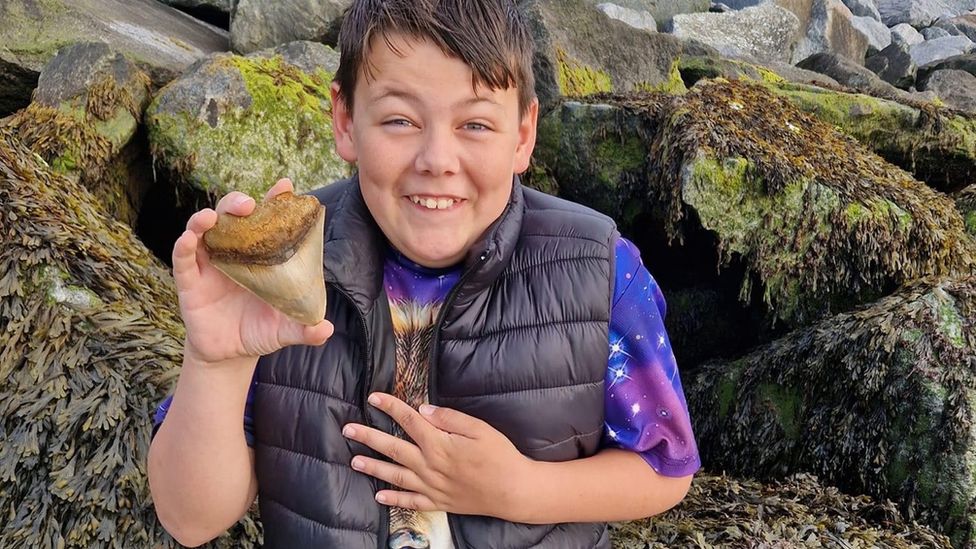ARTICLE AD BOX
 Image source, Family photo
Image source, Family photo
Ben with the 10cm-long (4in) tooth he found at Walton-on-the-Naze in Essex
By Kate Scotter
BBC News, Essex
A 13-year-old boy has found a shark tooth believed to have belonged to a giant prehistoric creature.
Ben discovered the 10cm-long (4in) tooth at Walton-on-the-Naze in Essex during a summer holiday weekend break.
The teenager's dad, Jason, said his son was "over the moon" with the find and knew the second he saw it "it was something".
Essex Wildlife Trust said it was a megalodon tooth and intact ones, like the one found, were a "rare find".
Jason and his son were on a weekend break from their home in Hemel Hempstead, Hertfordshire especially to go searching for fossils.
They arrived on Friday evening and by Sunday morning had already clocked up 16 miles (26km) of walking along the coast.
Essex Wildlife Trust said the tooth found by Ben was a megalodon
They were up at the crack of dawn on Sunday and were down at the beach first thing when Ben found the giant tooth under rocks at about 07:00 BST.
Jason, 50, said: "We could just see the edge of it, sticking out, and Ben knew straightaway it was something and pulled it out of the sand."
The pair took their find to Essex Wildlife Trust's Discovery Centre at Walton-on-the-Naze where they were told it was a megalodon tooth.
Jason said he and his son go to Walton-on-the-Naze to go fossil hunting once a year and also to the Jurassic Coast, a 95-mile (153km) long stretch of coastline in southern England.
He said Ben wants to be a palaeontologist when he is older and the giant tooth was a "great addition" to his collection.
Essex Wildlife Trust said the tooth would be from 20 million years old to 3.6 million.
It said several had been found at The Naze but more commonly they were fragments of the teeth.
The megalodon
Image source, Getty Images
Image caption,Megalodon was a giant and dwarfed all other sea creatures
The cartilaginous fish (whose skeleton is made of cartilage rather than bone) was a carnivore and had no known predators
- It could eat anything it liked, but its favourite food was whales, although seals would also have been on the menu
- Most of this shark's hunting was in the open sea (juveniles lived closer to shore) and it attacked its prey near the surface, when it came up for air
- Megalodon could swim at high speed in short bursts so tended to rush its prey from beneath
- It would first aim to disable its prey by injuring a flipper or the tail, then once unable to swim properly, the victim would be easier to finish off
- Lived from about 20 million years ago, long after the dinosaurs became extinct 65 million years ago
Find BBC News: East of England on Facebook and Instagram. If you have a story suggestion email eastofenglandnews@bbc.co.uk or get in touch via WhatsApp on 0800 169 1830
Related Internet Links
The BBC is not responsible for the content of external sites.

 1 year ago
214
1 year ago
214








 English (US) ·
English (US) ·